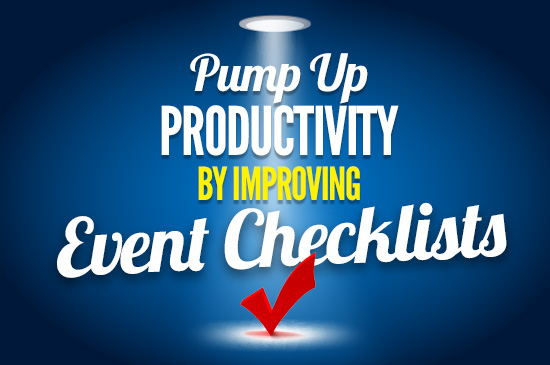Pre-event checklists, day-of agendas and post-event wrap sheets are essential to the success of events. So how can you ensure your event checklists are productive and beneficial to you and your staff?

Often times this continuous series of to-do lists can be overwhelming and mundane, but as event managers, we rely on checklists to assist us in our planning process. As we all know, events evolve during the planning stages and every event is different, so although you are attempting to stay on task with your checklists, sometimes these lists become more trouble than they’re worth.
Here are a few tips to set you on the right track to start making the most of your event checklists:
Create Official Checklists
We all have our own process in place for planning events and while we may not feel the need to have formal checklists in place, they can provide many different benefits. Increased organization, improved productivity and better staff communication can all be attributed to a great checklist system.
Before you start working on your next event, sit down and organize out everything you need to do. Once you have a full to-do list, categorize the tasks and start a fresh formalized event checklist. Although this might sound like a tall task now, it will pay great dividends in the long run!
Ensure that your staff are aware of the checklist and integrate it into your planning routine. Having well-presented and organized documents makes everyone’s job easier and keeps your team on the same page with what has been accomplished and what still needs attention.
Compare Your Checklists
There are hundreds of event checklists on the web and, although they may not be tailored specifically for your event, they can provide you with a great starting point. Begin by finding one that aligns well with your type of event, such as a wedding, corporate outing, or charity fundraiser and expand on it to further fit your needs.
You could also speak with your event planning colleagues or coworkers and compare notes. You may already be a member of an event planning association or part of a LinkedIn group where many other planners are available and willing to help you.
You could make it a collective effort and review each other’s event documents. Collaborating like this is a great way to build your relationships in the industry and expand your knowledge as a planner. It is always nice to have a fresh set of eyes on any aspect of your event. Taking a look at other planners’ checklist can provide you both with new ideas and help you to remember something you may have initially left off of your list.
Proper Checklist Layout
When creating your checklist make sure that you use a layout that works well for you. Some planners organize their lists by category such as attendees, budget, venue, and transportation, while others may prefer to have the checklist in a timeline format.
You can also integrate the two by having your checklist sorted by timeline, while also utilizing tags or color codes to signify specific categories. This will allow you to see your list in multiple views at a quick glance. You will know where you stand on your timeline and also what categories may need additional support or attention.
Assign Tasks To Your Checklist
You can easily use your checklists to delegate tasks to your staff. Beside each task, include an assignment section and write in the name of the lead person. This provides accountability for your staff and gives them an added sense of responsibility and ownership. In addition, this provides you with a big-picture look at how many staff members you may need and how much everyone has on his or her plate.
You can also make this a fun and interactive process for your staff by rewarding them as tasks are accomplished. Small bonuses such a gift card or special recognition can go a long way in keeping your staff motivated and dedicated to your event!
Assigning tasks will also give you the opportunity to decide which tasks can be delegated and which tasks must be completed by you as the lead planner. Letting go of certain tasks can be a challenge, but when you see everything on your checklist you will have a clear picture of how much needs to be accomplished. Assign yourself to the priority tasks and delegate the supplementary items.
Expand and Evaluate Your Checklist Following Events
As each event progresses, you should add to your checklist and continue building upon your system. You will gather more items as each event is completed and your checklist will grow into an essential part of your planning process.
Following your events you may hold a recap meeting to review your successes and possible areas of improvement. During this event review, be sure to not only look at what occurred during your event, but also take time to evaluate your planning process and checklist system. Be sure to look at what went well and what can be improved in the future. With each event, your checklists will become more helpful and integral to you and your team.
In Conclusion
Checklists can become overwhelming if you don’t take the time to organize and prepare them. Starting out on the right foot with your event checklist will set the tone for your planning process and drive your productivity.
In the end, you will become more efficient as an event planner and your events will improve, because you have an organized and focused process. This extra bit of organization provides for less wasted time and more energy to focus on making your events exciting and enjoyable for your attendees!





